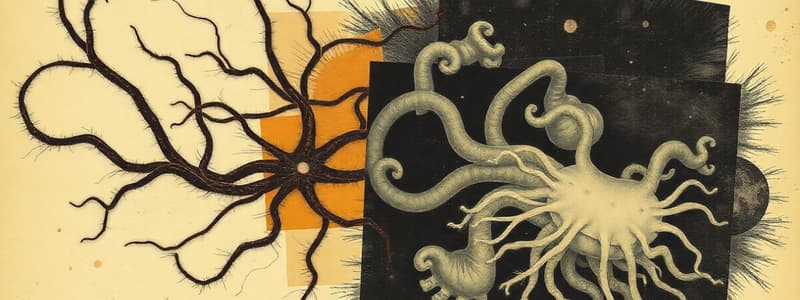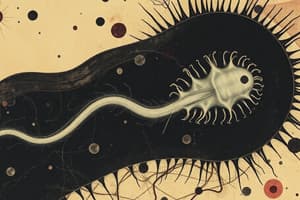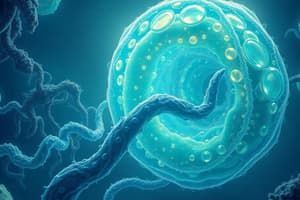Podcast
Questions and Answers
Which of the following protozoan parasites is responsible for amoebic dysentery?
Which of the following protozoan parasites is responsible for amoebic dysentery?
- Leishmania
- Toxoplasma gondii
- Plasmodium spp
- Entamoeba histolytica (correct)
Invasive strains of Entamoeba cause symptoms primarily through the invasion of epithelial cells lining the intestine.
Invasive strains of Entamoeba cause symptoms primarily through the invasion of epithelial cells lining the intestine.
True (A)
What is the primary mode of transmission for Entamoeba histolytica?
What is the primary mode of transmission for Entamoeba histolytica?
Through food, fomites, fingers, feces, and flies.
The cyst wall of Entamoeba histolytica is primarily composed of ______.
The cyst wall of Entamoeba histolytica is primarily composed of ______.
Match the following protozoa with their respective lineages:
Match the following protozoa with their respective lineages:
What are the two main stages in the life cycle of Entamoeba histolytica?
What are the two main stages in the life cycle of Entamoeba histolytica?
All strains of Entamoeba histolytica are highly virulent and cause severe gastrointestinal symptoms.
All strains of Entamoeba histolytica are highly virulent and cause severe gastrointestinal symptoms.
The trophozoite stage of Entamoeba histolytica is responsible for ______ and ______.
The trophozoite stage of Entamoeba histolytica is responsible for ______ and ______.
What is the primary role of E.histolytica's Gal/GalNAc lectin?
What is the primary role of E.histolytica's Gal/GalNAc lectin?
E.histolytica can cause serious intestinal ulcers that may be invaded by bacteria.
E.histolytica can cause serious intestinal ulcers that may be invaded by bacteria.
What distinguishes E.histolytica from E.dispar in terms of pathogenicity?
What distinguishes E.histolytica from E.dispar in terms of pathogenicity?
The main protein secreted by E.histolytica that disrupts epithelial tight junctions is __________.
The main protein secreted by E.histolytica that disrupts epithelial tight junctions is __________.
Match the type of amoebiasis with its corresponding symptoms:
Match the type of amoebiasis with its corresponding symptoms:
Which enzyme is involved in the trogocytosis process of E.histolytica?
Which enzyme is involved in the trogocytosis process of E.histolytica?
Amoebic granulomas can be mistaken for tumors.
Amoebic granulomas can be mistaken for tumors.
What is the effect of trogocytosis on the immune recognition of E.histolytica?
What is the effect of trogocytosis on the immune recognition of E.histolytica?
Treatment for symptomatic amoebic dysentery often includes __________ or __________.
Treatment for symptomatic amoebic dysentery often includes __________ or __________.
What happens to the intestinal wall due to the ulcers caused by E.histolytica?
What happens to the intestinal wall due to the ulcers caused by E.histolytica?
Flashcards
Entamoeba histolytica
Entamoeba histolytica
A protozoan parasite that causes amoebic dysentery, characterized by invasive and non-invasive strains, and stool symptoms.
Amoebic dysentery
Amoebic dysentery
Inflammatory bowel disease caused by Entamoeba histolytica, featuring bloody and/or mucous stools.
Trophozoite
Trophozoite
The active, feeding, and replicating stage of an Entamoeba infection.
Cyst
Cyst
Signup and view all the flashcards
Non-invasive Entamoeba histolytica
Non-invasive Entamoeba histolytica
Signup and view all the flashcards
Invasive Entamoeba histolytica
Invasive Entamoeba histolytica
Signup and view all the flashcards
5 Fs of Transmission
5 Fs of Transmission
Signup and view all the flashcards
Extraintestinal amebiasis
Extraintestinal amebiasis
Signup and view all the flashcards
E. histolytica lectin
E. histolytica lectin
Signup and view all the flashcards
Pathogenesis of E. histolytica
Pathogenesis of E. histolytica
Signup and view all the flashcards
Virulence Factors
Virulence Factors
Signup and view all the flashcards
Trogocytosis
Trogocytosis
Signup and view all the flashcards
Liver Abscess
Liver Abscess
Signup and view all the flashcards
Amoebapore
Amoebapore
Signup and view all the flashcards
Cysteine Proteases
Cysteine Proteases
Signup and view all the flashcards
Treatment of Amoebiasis
Treatment of Amoebiasis
Signup and view all the flashcards
Study Notes
Amoebozoa Lineage - Entamoeba histolytica
-
Characteristics: Locomotion and feeding via pseudopodia; heterotrophic, consuming bacteria via phagocytosis; asexual reproduction by binary fission; parasitic forms infect humans and primates. Intestinal parasitic forms are anaerobic. Examples include Entamoeba, Endolimax, Balamuthia.
-
Entamoeba histolytica: Causes amoebic dysentery, characterized by bloody or mucus-containing stools, cramping, fever, and weight loss. Common in areas with high population density and poor sanitation. Many cases are asymptomatic.
Entamoeba Life Cycle
-
Two stages:
- Trophozoite: Actively growing, feeding, and replicating stage.
- Cyst: Transmission stage, resistant to environmental conditions.
-
Transmission: Five Fs (food, fomites, fingers, feces, flies).
Pathogenesis of E. histolytica
- Non-invasive (avirulent) strains: Trophozoites remain in intestinal lumen, causing mild GI symptoms or being asymptomatic. Can develop into invasive strains by penetrating the mucosa. These strains ingest bacteria and cellular debris and do not penetrate the mucosal layer.
- Invasive (virulent) strains: Trophozoites invade intestinal cells, spread to underlying tissues, cause flask-shaped ulcers, and lead to extensive bleeding. Hematophagous trophozoites rapidly replicate, causing ulcer expansion and necrotic colitis. Can cause extraintestinal amebiasis, spreading via the circulatory system. Parasite enzymes further damage the host's extracellular matrix, leading to muscle and serous layer perforation, peritonitis, and extraintestinal infection spread.
Adherence to Host Mucosal Cells
- E. histolytica lectin: Binds tightly to host galactose (Gal) and N-acetyl-D-galactosamine (GalNAc) residues, crucial for adherence and virulence.
Virulence Mechanisms and Factors
- Virulent vs. Avirulent: E. histolytica is pathogenic, while E. dispar is not. Differences in lectin sequences and protein expression are contributing factors.
- Inflammation: E. histolytica lectins induce host inflammatory response; disrupt tight junctions, altering paracellular permeability.
- PGE2: E. histolytica secretes prostaglandin EG (PGE2) that disrupts epithelial tight junctions.
- Apoptosis: E. histolytica surface lectins trigger host cell apoptosis.
- Amoebopores: Perforate host membranes; E. histolytica has higher expression than E. dispar, contributing to host-cell lysis.
- Cysteine Proteases: Break down proteins, degrade the mucosal layer and extracellular matrix.
- Trogocytosis: E. histolytica ingests host cell fragments, acquiring host cell membrane proteins, potentially evading immune responses (MHC I proteins).
Immune Evasion
- Immune cell destruction: E. histolytica directly consumes host immune cells.
- Suppression of immune molecules: Suppresses IFN-γ and NF-κB.
- Complement system evasion: Thick impervious layer (LPPG) resists complement attack.
- Host proteins on parasite surface: Expressed MHC I proteins that inhibit MAC (membrane attack complex) formation, impeding innate immune responses,
- Anti-oxidative stress enzymes, neutralize host ROS.
- Cleaving IgA and IgG for inactivation: CPs (cysteine proteases) cleave host intestinal IgA antibodies and circulate IgG.
Extraintestinal Amebiasis
- Hepatic amoebiasis: Most common, involving liver abscesses ("anchovy sauce" appearance). Possible rupture to peritonitis, or to the lungs.
- Pulmonary amoebiasis: Liver abscess rupture through the diaphragm.
- Cutaneous amoebiasis: Perianal ulcers
- Amebic brain abscess: Rare, but dangerous in immunocompromised individuals.
Treatment
- Asymptomatic: Nitroimidazole, iodoquinol, paromomycin, or diloxanide furoate are options.
- Symptomatic/Colitis/Extraintestinal: Metronidazole or tinidazole are typical treatments
- Severe cases (Necrosis/perforations): Dehydroemetine or emetine may be necessary.
Studying That Suits You
Use AI to generate personalized quizzes and flashcards to suit your learning preferences.





